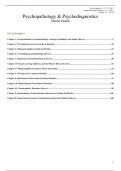Summary
Comprehensive Summary Psychopathology & Psychodiagnostics Test 1
- Course
- Institution
A very comprenhensive summary for Psychopathology & Psychodiagnostics test 1 including: - Chapters 1, 2.1, 7, 15 & 8 (Davey) -Chapters 1, 2, 3, 4 & 9 (Luteijn & Barelds) -Chapter 15, 17 & 18 (articles) (own grade 8.1)
[Show more]



